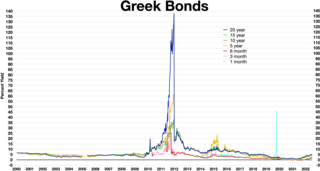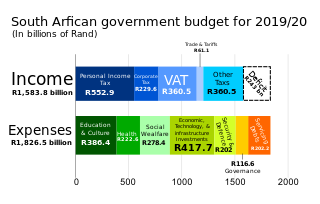Related Research Articles

The euro is the official currency of 20 of the 27 member states of the European Union. This group of states is officially known as the euro area or, more commonly, the eurozone. The euro is divided into 100 euro cents.
In economics, a recession is a business cycle contraction that occurs when there is a general decline in economic activity. Recessions generally occur when there is a widespread drop in spending. This may be triggered by various events, such as a financial crisis, an external trade shock, an adverse supply shock, the bursting of an economic bubble, or a large-scale anthropogenic or natural disaster.
In economics, deflation is a decrease in the general price level of goods and services. Deflation occurs when the inflation rate falls below 0%. Inflation reduces the value of currency over time, but deflation increases it. This allows more goods and services to be bought than before with the same amount of currency. Deflation is distinct from disinflation, a slowdown in the inflation rate; i.e., when inflation declines to a lower rate but is still positive.

In economics, cash is money in the physical form of currency, such as banknotes and coins.

The 1997 Asian financial crisis was a period of financial crisis that gripped much of East and Southeast Asia during the late 1990s. The crisis began in Thailand in July 1997 before spreading to several other countries with a ripple effect, raising fears of a worldwide economic meltdown due to financial contagion. However, the recovery in 1998–1999 was rapid, and worries of a meltdown quickly subsided.

The Reserve Bank of India, abbreviated as RBI, is India's central bank and regulatory body responsible for regulation of the Indian banking system. Owned by the Ministry of Finance, Government of India, it is responsible for the control, issue and maintaining supply of the Indian rupee. It also manages the country's main payment systems and works to promote its economic development. Bharatiya Reserve Bank Note Mudran (BRBNM) is a specialised division of RBI through which it prints and mints Indian currency notes (INR) in two of its currency printing presses located in Mysore and Salboni. The RBI, along with the Indian Banks' Association, established the National Payments Corporation of India to promote and regulate the payment and settlement systems in India. Deposit Insurance and Credit Guarantee Corporation was established by RBI as one of its specialized division for the purpose of providing insurance of deposits and guaranteeing of credit facilities to all Indian banks.

Fractional-reserve banking is the system of banking in all countries worldwide, under which banks that take deposits from the public keep only part of their deposit liabilities in liquid assets as a reserve, typically lending the remainder to borrowers. Bank reserves are held as cash in the bank or as balances in the bank's account at the central bank. Fractional-reserve banking differs from the hypothetical alternative model, full-reserve banking, in which banks would keep all depositor funds on hand as reserves.

A country's gross government debt is the financial liabilities of the government sector. Changes in government debt over time reflect primarily borrowing due to past government deficits. A deficit occurs when a government's expenditures exceed revenues. Government debt may be owed to domestic residents, as well as to foreign residents. If owed to foreign residents, that quantity is included in the country's external debt.
Foreign exchange reserves are cash and other reserve assets such as gold and silver held by a central bank or other monetary authority that are primarily available to balance payments of the country, influence the foreign exchange rate of its currency, and to maintain confidence in financial markets. Reserves are held in one or more reserve currencies, nowadays mostly the United States dollar and to a lesser extent the euro.

Money creation, or money issuance, is the process by which the money supply of a country, or an economic or monetary region, is increased. In most modern economies, money is created by both central banks and commercial banks. Money issued by central banks is termed reserve deposits and is only available for use by central bank account holders, which are generally large commercial banks and foreign central banks. Central banks can increase the quantity of reserve deposits directly, by engaging in open market operations or quantitative easing. However, the majority of the money supply used by the public for conducting transactions is created by the commercial banking system in the form of bank deposits. Bank loans issued by commercial banks expand the quantity of bank deposits.
The Convertibility plan was a plan by the Argentine Currency Board that pegged the Argentine peso to the U.S. dollar between 1991 and 2002 in an attempt to eliminate hyperinflation and stimulate economic growth. While it initially met with considerable success, the board's actions ultimately failed. The peso was only pegged to the dollar until 2002.
The Triffin dilemma is the conflict of economic interests that arises between short-term domestic and long-term international objectives for countries whose currencies serve as global reserve currencies. This dilemma was identified in the 1960s by Belgian-American economist Robert Triffin, who noted how the country whose currency is the global reserve currency, that foreign nations wish to hold as foreign exchange (FX) reserves, must be willing to supply the world with an extra supply of its currency in order to fulfill world demand for these FX reserves, leading to a trade deficit.
At the micro-economic level, deleveraging refers to the reduction of the leverage ratio, or the percentage of debt in the balance sheet of a single economic entity, such as a household or a firm. It is the opposite of leveraging, which is the practice of borrowing money to acquire assets and multiply gains and losses.

The Great Recession was a period of marked general decline observed in national economies globally, i.e. a recession, that occurred in the late 2000s. The scale and timing of the recession varied from country to country. At the time, the International Monetary Fund (IMF) concluded that it was the most severe economic and financial meltdown since the Great Depression. One result was a serious disruption of normal international relations.
In monetary economics, the currency in circulation in a country is the value of currency or cash that has ever been issued by the country’s monetary authority less the amount that has been removed. More broadly, money in circulation is the total money supply of a country, which can be defined in various ways, but always includes currency and also some types of bank deposits, such as deposits at call.
While beginning in the United States, the Great Recession spread to Asia rapidly and has affected much of the region.

The Lost Decades is a lengthy period of economic stagnation in Japan precipitated by the asset price bubble's collapse beginning in 1990. The singular term Lost Decade originally referred to the 1990s, but the 2000s and the 2010s have been included by commentators as the phenomenon continued.

Greece faced a sovereign debt crisis in the aftermath of the financial crisis of 2007–2008. Widely known in the country as The Crisis, it reached the populace as a series of sudden reforms and austerity measures that led to impoverishment and loss of income and property, as well as a "humanitarian crisis". In all, the Greek economy suffered the longest recession of any advanced mixed economy to date. As a result, the Greek political system was upended, social exclusion increased, and hundreds of thousands of well-educated Greeks left the country.

The national debt of South Africa is the total quantity of money borrowed by the Government of South Africa at any time through the issue of securities by the South African Treasury and other government agencies.
The Economy monetization is a metric of the national economy, reflecting its saturation with liquid assets. The level of monetization is determined both by the development of the national financial system and by the whole economy. The monetization of economy also determines the freedom of capital movement. Long time ago scientists recognized the important role played by the money supply. Nevertheless, only approximately 50 years ago did Milton Friedman convincingly prove that change in the money quantity might have a very serious effect on the GDP. The monetization is especially important in low- to middle-income countries in which it is substantially correlated with the per-capita GDP and real interest rates. This fact suggests that supporting an upward monetization trend can be an important policy objective for governments.
References
- 1 2 3 Ashworth, J.; Goodhart, C.A.E. (2020). "The surprising recovery of currency usage" (PDF). International Journal of Central Banking. 16 (3): 239–277.
- ↑ Bailey, A. (2009, December 6). Banknotes in circulation: Still rising. what does this mean [Speech transcript]. Bank of England. https://www.bankofengland.co.uk/-/media/boe/files/speech/2009/banknotes-in-circulation-still-rising.pdf
- 1 2 Pietrucha, Jacek (16 December 2021). "Drivers of the Cash Paradox". Risks. 9 (12): 227. doi: 10.3390/risks9120227 . hdl: 10419/258309 .
- 1 2 IMF. 2024. International Monetary Fund International Financial Statistics. Available online: https://data.imf.org (accessed on 9 April 2024)
- 1 2 3 Ashworth, Jonathan; Goodhart, Charles (15 November 2021). "The Great COVID Cash Surge - Digitalisation Hasn't Dented Cash's Safe Haven Role". Centre for Economic Policy Research. SSRN 3960199.
- ↑ Huterska, Agnieszka; Piotrowska, Anna Iwona; Szalacha-Jarmużek, Joanna (11 July 2021). "Fear of the COVID-19 Pandemic and Social Distancing as Factors Determining the Change in Consumer Payment Behavior at Retail and Service Outlets". Energies. 14 (14): 4191. doi: 10.3390/en14144191 .
- ↑ Kotkowski, Radoslaw (9 November 2022). "National culture and the demand for physical money during the first year of the COVID-19 pandemic". Finance Research Letters. 51. doi:10.1016/j.frl.2022.103483. PMC 9664053 . PMID 36407757.
- ↑ "World Bank Open Data". World Bank Open Data. Retrieved 2024-04-10.
- 1 2 3 4 Rösl, Gerhard; Seitz, Franz (2021) : Cash demand in times of crises, Weidener Diskussionspapiere, No. 83, ISBN 978-3-937804-86-6, Ostbayerische Technische Hochschule Amberg-Weiden (OTH), Weiden i.d.OPf.
- ↑ Board of Governors of the Federal Reserve System (US) (1917-08-01). "Currency in Circulation". FRED, Federal Reserve Bank of St. Louis. Retrieved 2024-04-12.
- ↑ Bank, European Central (2023-08-07). "Circulation". European Central Bank. Retrieved 2024-04-12.
- ↑ Peritz, L.; Weldzius, R.; Rogowski, R.; Flaherty, T. (2021). "Enduring the great recession: Economic integration in the European Union". The Review of International Organizations. 17 (1): 175–203. doi:10.1007/s11558-020-09410-0. PMC 7779645 . PMID 35721791.
- 1 2 3 Jobst, Clemens; Stix, Helmut (26 September 2017). "Doomed to Disappear? The Surprising Return of Cash Across Time and Across Countries". Center for Economic Policy Research.
- ↑ Leahy, John V.; Whited, Toni M. (1996). "The Effect of Uncertainty on Investment: Some Stylized Facts". Journal of Money, Credit and Banking. 28 (1): 64–83. doi:10.2307/2077967. JSTOR 2077967.
- ↑ Willesson, Magnus; Liñares-Zegarra, José M. (25 November 2020). "The effects of negative interest rates on cash usage: Evidence for EU countries". Economics Letters. 198. doi:10.1016/j.econlet.2020.109674. ISSN 0165-1765.
- ↑ "World Bank Open Data". World Bank Open Data. Retrieved 2024-04-12.
- ↑ "Dollar Dominance and the Rise of Nontraditional Reserve Currencies". IMF. 2022-06-01. Retrieved 2024-04-12.
- ↑ " ". data.imf.org. Retrieved 2024-04-12.
- ↑ International Monetary Fund (1977-12-01). "Total Reserves excluding Gold for China". FRED, Federal Reserve Bank of St. Louis. Retrieved 2024-04-12.
- ↑ "China forex reserves rise to $3.246 trln in March". Reuters. 2024-04-07. Retrieved 2024-04-12.
- ↑ ""The International Role of the U.S. Dollar" Post-COVID Edition, Accessible Data". www.federalreserve.gov. Retrieved 2024-04-12.
- ↑ Zamora-Pérez, Alejandro (2021). "The paradox of banknotes: understanding the demand for cash beyond transactional use". European Central Bank Economic Bulletin (2/2021).